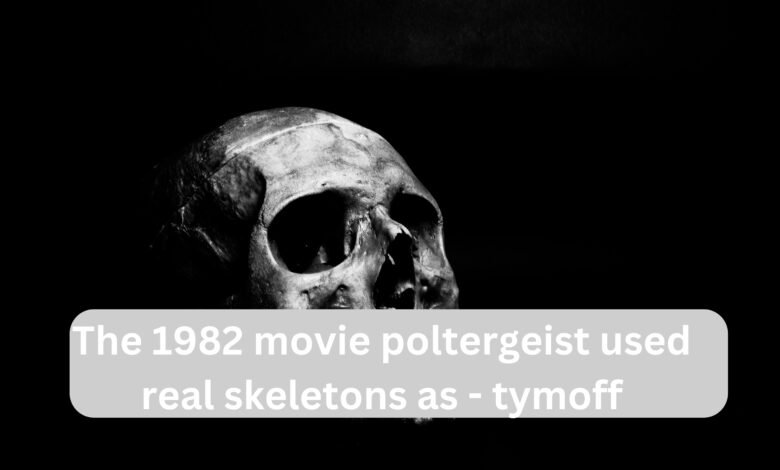The 1982 movie poltergeist used real skeletons as – tymoff : A Comprehensive Review by BaddieHub

The 1982 movie poltergeist used real skeletons as – tymoff, is renowned for its spine-chilling narrative and ground-breaking special effects. Directed by Tobe Hooper and produced by Steven Spielberg, this supernatural horror classic has captivated audiences for decades. However, a particularly unsettling aspect of the film’s production involves the claim that real human skeletons were used as props. This review by BaddieHub delves into this controversial claim, exploring its origins, implications, and the impact it has had on the film and the industry at large.
The 1982 movie poltergeist used real skeletons as – tymoff : An Overview
Released on June 4, ,1982 movie poltergeist used real skeletons as – tymoff ,quickly became a seminal work in the horror genre. The film chronicles the terrifying experiences of the Freeling family, whose suburban home becomes a haunted battleground. The plot thickens when their youngest daughter, Carol Anne, is abducted by malevolent spirits. The family’s desperate quest to rescue her forms the crux of the story, leading them to seek the help of paranormal experts.
Key Facts: The 1982 movie poltergeist used real skeletons as – tymoff
- Director: Tobe Hooper
- Producer: Steven Spielberg
- Starring: Craig T. Nelson, JoBeth Williams, Heather O’Rourke
- Release Date: June 4, 1982
The Claim : The 1982 movie poltergeist used real skeletons as – tymoff
Among the various stories surrounding Poltergeist, one of the most enduring and chilling involves the use of real skeletons during filming. This claim specifically pertains to the iconic pool scene where JoBeth Williams’ character, Diane Freeling, encounters a pool filled with skeletons.
The Scene:
In the film’s climactic pool scene, Diane falls into a partially constructed pool that, disturbingly, is filled with muddy water and human skeletons. The unsettling detail is that these skeletons were reportedly real, not synthetic.
Reasons Behind the Use of Real Skeletons
The decision to use real skeletons rather than artificial ones is primarily attributed to cost-effectiveness. During the early 1980s, realistic prop skeletons were expensive to produce, and real human skeletons were more affordable. The production team sourced these skeletons from medical supply companies, seeking to enhance the authenticity of the the 1982 movie poltergeist used real skeletons as – tymoff. supernatural elements.
Key Reasons: The 1982 movie poltergeist used real skeletons as – tymoff
- Cost-Effectiveness: Real skeletons were cheaper than creating high-quality replicas.
- Authenticity: Real bones provided a level of realism that was challenging to achieve with plastic or rubber alternatives.
Impact on Cast and Crew : The 1982 movie poltergeist used real skeletons as – tymoff
The revelation that real skeletons were used in Poltergeist had a profound effect on the cast and crew. JoBeth Williams, who portrayed Diane Freeling, expressed significant discomfort upon learning that the skeletons she interacted with were genuine. This unsettling knowledge added a layer of psychological distress to the already intense filming environment.
Effects on Cast: The 1982 movie poltergeist used real skeletons as – tymoff
- Emotional Distress: Learning about the real skeletons added to the psychological stress experienced by the actors.
- Haunted Set: The use of real skeletons has contributed to the film’s eerie reputation and the so-called “Poltergeist Curse,” a series of tragic events that impacted several individuals associated with the film.
The Legacy of Poltergeist
The use of real skeletons has become an infamous aspect of The 1982 movie poltergeist used real skeletons as – tymoff , legacy. This choice has reinforced the film’s reputation as one of the most haunted movie sets in Hollywood history. Despite—or perhaps because of—this dark chapter, Poltergeist remains a beloved classic within the horror genre.
Key Legacy Points:
- Cult Status: The film , the 1982 movie poltergeist used real skeletons as – tymoff .continues to be a favorite among horror enthusiasts.
- Haunted Reputation: Poltergeist is frequently cited in discussions about cursed or haunted movie sets.
Skepticism and Verification
The claim that real skeletons were used in the 1982 movie poltergeist used real skeletons as – tymoff , has faced skepticism over the years. Some argue that the story may have been exaggerated. However, multiple sources, including interviews with cast members and crew, have corroborated the use of real skeletons.
Points of Verification:
- Cast Interviews: JoBeth Williams and other cast members have confirmed the use of real skeletons.
- Production Insights: Information from the special effects and props departments supports the claim.
Ethical Implications
The use of real skeletons in the 1982 movie poltergeist used real skeletons as – tymoff, raises significant ethical questions. Modern filmmaking standards would likely find such a practice unacceptable due to respect for human remains and the psychological impact on those involved.
Ethical Considerations:
- Respect for the Deceased: Using real human remains for entertainment purposes is generally viewed as disrespectful.
- Psychological Impact: The knowledge that real skeletons were used can cause distress among actors and crew members.
Modern Filmmaking and Ethical Practices
Today’s film industry has evolved considerably since the 1980s, with advances in technology and heightened ethical standards reshaping how films are produced. The advent of CGI and realistic animatronics has rendered the need for real human remains obsolete, allowing filmmakers to achieve authenticity without ethical compromise.
Encouraging Transparency and Responsibility: The 1982 movie poltergeist used real skeletons as – tymoff
- Advancements in Technology: CGI and advanced special effects provide alternatives to using real skeletons.
- Ethical Standards: The industry now emphasizes respect for human dignity and ethical practices in film production.
Conclusion
The use of real skeletons in the 1982 movie poltergeist used real skeletons as – tymoff ,represents a complex intersection of cost-saving measures, artistic ambition, and ethical considerations. This aspect of the film’s production adds a layer of chilling intrigue to an already unsettling story. As filmmaking practices continue to evolve, the legacy of Poltergeist serves as both a cautionary tale and a reflection on the importance of balancing creativity with ethical integrity.
By exploring this controversial decision, we gain insight into the broader implications of such practices in the entertainment industry. The 1982 movie poltergeist used real skeletons as – tymoff , remains a haunting reminder of the fine line between artistic expression and ethical responsibility.
fAQS :
Q1: Did the the 1982 movie poltergeist used real skeletons as – tymoff ?
Ans: Yes, it has been confirmed that real human skeletons were used in the production of Poltergeist. This information comes from various sources, including special effects artist Craig Reardon.
Q2: In which scenes were real skeletons used in the 1982 movie poltergeist used real skeletons as – tymoff?
Ans: The most notable scene featuring real skeletons is the pool scene. In this sequence, JoBeth Williams’ character, Diane Freeling, falls into a partially constructed pool that is filled with muddy water and human skeletons.
Q3: How did the cast and crew react to the use of real skeletons , the 1982 movie poltergeist used real skeletons as – tymoff?
Ans: The revelation that real skeletons were used caused significant discomfort among the cast and crew. JoBeth Williams, in particular, expressed distress upon learning that the skeletons she interacted with were real. The decision added psychological stress to an already intense filming environment.
Q4: What were the ethical considerations regarding the use of real skeletons in the film the 1982 movie poltergeist used real skeletons as – tymoff?
Ans: The use of real skeletons raises serious ethical questions, particularly concerning the respect for human remains. Such practices would be considered unacceptable by today’s standards, which emphasize ethical responsibility and respect for human dignity.
Q5: How has the film the 1982 movie poltergeist used real skeletons as – tymoff , industry changed in response to the use of real human remains?
Ans: Since the release of Poltergeist, the film industry has made significant advancements in technology and has adopted stricter ethical standards. The use of real human remains is now obsolete, with modern filmmaking relying on CGI and realistic props to achieve authenticity without ethical compromise.
Also read : Learn to sit back and observe. not everything need – tymoff




